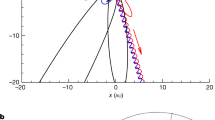Abstract
One of the fundamental aspects of statistical behaviour in many-body systems is exponential divergence of neighbouring orbits, which is often discussed in terms of Liapounov exponents. Here we study this topic for the classical gravitational N-body problem. The application we have in mind is to old stellar systems such as globular star clusters, where N∼106, and so we concentrate on spherical, centrally concentrated systems with total energy E<0. Hitherto no connection has been made between the time scale for divergence (denoted here by t e ) and the time scale on which the energies of the particles evolve because of two-body encounters (i.e., the two-body relaxation time scale, t r ), even though both may be calculated by similar considerations. In this paper we give a simplified model showing that divergence in phase space is initially roughly exponential, on a timescale proportional to the crossing time (defined as a mean time for a star to cross from one side of the system to another). In this phase t e <<t r , if N is not too small (i.e., N≫30). After several e-folding times, the model shows that the divergence slows down. Thereafter the divergence (measured by the energies of the bodies) varies with time as t 1/2, on a timescale nearly proportional to the familiar two-body relaxation timescale, i.e., t e ∼t r in this phase. These conclusions are illustrated by numerical results.
Similar content being viewed by others
REFERENCES
R. H. Miller, Irreversibility in small stellar dynamical systems, ApJ 140:250–256 (1964).
J. Binney and S. Tremaine, Galactic Dynamics (Princeton University Press, Princeton, 1987).
J. Goodman, D. C. Heggie, and P. Hut, On the exponential instability of N-body systems, ApJ 415:715–733 (1993).
M. Hemsendorf and D. Merritt, Instability of the gravitational N-body problem in the large-N limit (2002), astro-ph/0205538.
H. E. Kandrup and H. Smith, On the sensitivity of the N-body problem to small changes in initial conditions, ApJ 374:255–65 (1991).
S. Chandrasekhar, Principles of Stellar Dynamics (University of Chicago Press, Chicago, 1942); also (Dover Publications, New York, 1960).
D. Merritt, Non-integrable galactic dynamics, in The Restless Universe, B. A. Steves and A. J. Maciejewski, eds. (SUSSP Publications, Edinburgh; and Institute of Physics Publishing, London, 2001).
N. S. Krylov, Works on the Foundations of Statistical Physics (Princeton University Press, Princeton, 1979).
Author information
Authors and Affiliations
Rights and permissions
About this article
Cite this article
Hut, P., Heggie, D.C. Orbital Divergence and Relaxation in the Gravitational N-Body Problem. Journal of Statistical Physics 109, 1017–1025 (2002). https://doi.org/10.1023/A:1020472526203
Issue Date:
DOI: https://doi.org/10.1023/A:1020472526203




